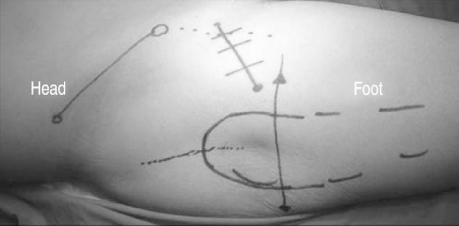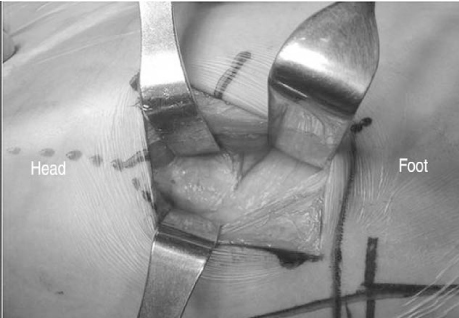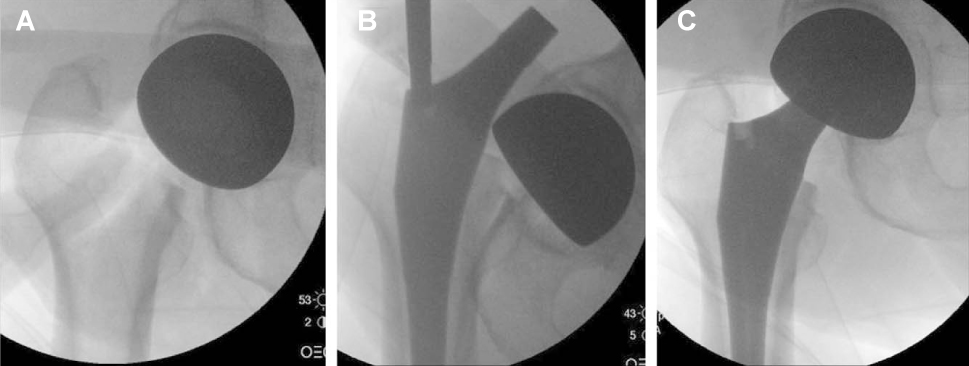J Korean Hip Soc.
2010 Sep;22(3):203-208. 10.5371/jkhs.2010.22.3.203.
Two-Incision Bipolar Hemiarthroplasty for Treating Femoral Neck Fracture: Analysis of 15 Cases
- Affiliations
-
- 1Department of Orthopaedic Surgery, Kwangju Christian Hospital, Gwangju, Korea. paedic@chol.com
- KMID: 1461171
- DOI: http://doi.org/10.5371/jkhs.2010.22.3.203
Abstract
- INTRODUCTION
We wanted to evaluate the efficacy of bipolar hemiarthroplasty using Berger's two-incision surgical technique for patients with muscular weakness around the hip joint and/or a high risk of dislocation.
MATERIALS AND METHODS
We performed bipolar hemiarthroplasty for 15 femoral neck fractures using Berger's two-incision technique between December 2005 and July 2007. The mean age of the patients was 75.2 years old. Four of them had difficulty in walking due to the sequalae after stroke and five have been treated for psychoneurologic disorders. We investigated the operation time, the length of the anterior and posterior incisions, the amount of bleeding, the time untill walking after the operation, the total hospital stay, the recovery to activities of daily living and the complications such as dislocation.
RESULTS
The mean operating time was 93 minutes. The average anterior and posterior skin incision length was 6.4 cm and 7.2 cm, respectively. The mean amount of bleeding was 420 cc at the time of surgery and 230 cc postoperatively through a drain. The patients started walking at a mean of 3.3 (1 to 5) days after the operation and the mean hospitalization was 24.3 days. Fourteen patients went back to their pre-injured activities of daily living, except one case with an intraoperative periprosthetic fracture. As for complications, two cases (13.3%) of femoral fracture were intraoperatively observed and one case of skin necrosis on the anterior incision site occurred. There were not any cases of dislocation or infection.
CONCLUSION
Two-incision bipolar hemiarthroplasty had advantages for rehabilitation in elderly patients who have a high risk of dislocation, as well as in the patients with muscle weakness. But the operation took a long time and it had a high complication rate.
Keyword
MeSH Terms
Figure
Reference
-
1. Jain NB, Losina E, Ward DM, Harris MB, Katz JN. Trends in surgical management of femoral neck fractures in the United States. Clin Orthop Relate Res. 2008. 466:3116–3122.
Article2. Rogmark C, Johnell O. Primary arthroplasty is better than internal fixation of displaced femoral neck fracture: a meta-analysis of 14 randomized studies with 2,289 patients. Acta Orthop. 2006. 77:359–367.
Article3. Berger RA. Total hip arthroplasty using the minimally invasive two-incision approach. Clin Orthop Relat Res. 2003. 417:232–241.4. Bal BS, Lowe JA. Muscle damage in minimally invasive total hip arthroplasty: MRI evidence that it is not significant. Instr Course Lect. 2008. 57:223–229.5. Hur CI, Yoon TR, Park KS, Cho SG, Yim JH. Minimally invasive two-incision total hip arthroplasty for treating acute displaced femoral neck fractures in active elderly patients. J Korean Orthop Assoc. 2008. 43:643–650.
Article6. Yoon TR, Bae BH, Choi MS. A modified two-incision minimally invasive total hip arthroplasty: technique and short-term results. Hip Int. 2006. 16:Suppl 4. 28–34.
Article7. Meneghini RM, Pagnano MW, Trousdale RT, Hozack WJ. Muscle damage during MIS total hip arthroplasty: Smith-Petersen versus posterior approach. Clin Orthop Relat Res. 2006. 453:293–298.8. Woolson ST. In the absence of evidence--why bother? A literature review of minimally invasive total hip replacement surgery. Instr Course Lect. 2006. 55:189–193.9. Macaulay W, Nellans KW, Iorio R, Garvin KL, Healy WL, Rosenwasser MP. DFACTO Consortium. Total hip arthroplasty is less painful at 12 months compared with hemiarthroplasy in treatment of displaced femoral neck fracture. HSS J. 2008. 4:48–54.
Article10. Iorio R, Healy WL, Lemos DW, Appleby D, Lucchesi CA, Saleh KJ. Displaced femoral neck fractures in the elderly: outcomes and cost effectiveness. Clin Orthop Relat Res. 2001. 383:229–242.11. Ninh CC, Sethi A, Hatahet M, Les C, Morandi M, Vaidya R. Hip dislocation after modular uniploar hemiarthroplasty. J Arthroplasty. 2009. 24:768–774.
- Full Text Links
- Actions
-
Cited
- CITED
-
- Close
- Share
- Similar articles
-
- Unipolar Versub Bipolar Hip Hemiarthroplasty for Fractures of Femoral Neck in the Dlderly
- Experience with Bipolar Hemiarthroplasty in Femoral Neck Fracture in the Elderly Patients: Correlation Between Preoperative Medical Conditions and Postoperative Functional Results of Hip
- Cementless Bipolar Hemiarthroplasty for the Management of Fracture of the Femoral Neck
- Bipolar hemiarthroplasty as secondary procedure for femoral neck fractures in young adults
- The Clinical Resuts of Bipolar Hemiarthroplasty in Old Age-Femoral Neck Fracture vs. Intertrochanteric Fracture-




